Box without reflectors/Box with reflectors/
Box without reflectors
Box-type cookers are very old and one of the most popular at present. The very first design of box-type cooker was supposed to be that of Nicholas-de-Saussure (1740-1799). It was simply an insulated box with glazing; this forms the basis of all the present designs of box-type cookers including Warenham’s (1995) ‘Sunstove’ (Type BWM 1d).
The cookers presented here are classified on the basis of reflectors, as those without reflector mirrors and those with mirrors. The cookers of the second category are further divided into five groups based on the number of reflectors as summarized in chart Ib.
WITHOUT
MIRRORS
WITH MIRRORS Single mirrors
Continued in next column |
Double
mirrors
Three mirrors
Four mirrors
Four plus four
|
Source:- TIDE., March 1998, 8-1, pp 1-37, For Comments, suggestions,contributions contact <
Please add, Solar or Solar Cooker, in the subject to avoid your mail being erased as scam
Nicholas-de-Saussure design (Type BWM 1, Figure 39) was probably the first solar cooker to appear on the scene in the 18th century (Walton 1977). It was simply an insulated box with two glass panes forming the cover. Vaughen (1979) has recommended such a box with a slight difference. It is a typical box type meant for villagers. A rectangular pit is dug in the ground, suitably insulated with hay or rice husk, and a box not taller than 10 cm made of metal sheet is fixed into this pit, and then covered with two glass panes with about 2-3 ½ cm space in between. Such a cooker would work well,in most parts of the sunny country, such as Africa and India, at least during summer, but to increase the efficiency it would be essential to add a reflector.
The author’s endeavours with solar cooking started with a similar design but the box constructed with mud above the ground. Round Aluminium boxes painted with balckboard paint acted as cooking vessels. Results were good, though at times the rice cooked was rather bland, indicating lower temperature.
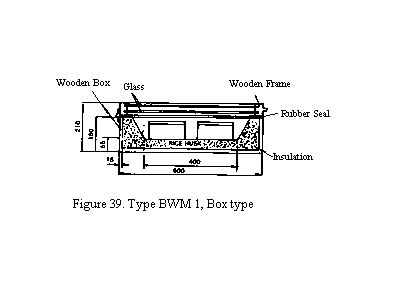
Larger versions of such box-type cookers are being tried out successfully (Nahar et al. 1996; Singh 1993). The Chinese type (BWM 1b) and Brace Research Institute Designs, called food warmer (BWM 1c) (VITA 1961) appear to be similar designs. The food warmer, with better insulation and triple glazing, is still popular (Warenham 1995). Kumar, Kishore (1994) have made the box circular. Many other minor variations are reported, even for the cooking vessels, fixing knobs for the lid and ‘ears’ for the base, making the lid of the vessel concave (Arora, Sharma 1993). Some more design modifications will be discussed later in the text. The nineteenth century cooker of Herschel (Type BWM 2) was probably built on similar lines (Meinel, Meinel 1977). The box was buried in sand and covered with two glass panes, stagnation temperature of 116oC was reported. It is on record that certain nomadic groups of Saudi Arabia bury the food under the sand for cooking (BWM 3). The author feels that they could get their food cooked more reliably if they cover the area with a double glass dome (with the space in between vacuumed) with a knob for easier handling (Type BWM 3a, Concept VI, Figure 40).
This vacuum enclosure, Concept VI, was proposed in the year 1982 or so by me. But I do not think Mr. J.Samalea of Spain was ever aware of it. But the concept of Vacuum as a good thermal insulation is indeed very old, in fact older than Thermos flasks. But only problem was that the technique was never properly applied in Solar Cooker Technology. Now it is J Samalea, who has introduced this concept in Solar Cooking in 2002. His Vacuum Cooker has been announced through Solar Cooker Review of Solarcooking.org. The diagram of the unit is actually taken from Solar Cooker International of Nov. 2003. To know more please visit Salalea’s site http:// cocinasolar.com. ( This comment was introduced on 24th June 2003 ) . The diagram is clear enough, the inner glass bowls are painted black. While outer ones are clear, and in-between them vacuum is created.
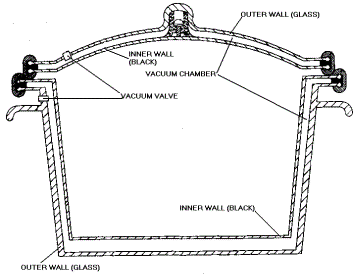
Mr Alex Kee of Malaysia, who has been advocating Solar Thermos tubes for water pasteurization,discovered that the stagnation temperature inside the tube could reach up to 2500C. He advocates that such tubes could be used for cooking as well. But the problem is small diameter of the tube. If the diameter of the tube is increased then problems like vacuum sealing will have to be encountered. Once this is solved the Tube cooker would emerge. I advice the reader to visit his site at http://solarwyse.cjb.net/.
Rathinasamy et al., (Type BWM 3 b)
have designed a rectangular box from sheet glass, (using popular
silicon glue used to construct fish tanks) of 50 x 50 x 22 cm,
and under this, the cooking vessels coated with suitable black
paint are kept under a temperature of 1100C
(Rathinasamy et al. 1988). Abou-Hussein had presented another interesting
variation. Here, the upper part of the box acts as a reflector
(Type BWM 4, Figure 41). The window of the box which lets the
light in is inclined at 450. The second glass pane is
flat and there is ample space between the first and the second
glass panes, and this space is used as a reflector. The design is
attractive but costly (Bowman, Blatt 1978). Source:- TIDE.,
March 1998, 8-1, pp 1-37, For
Comments, suggestions,contributions contact <
Please add, Solar or Solar Cooker, in the subject to avoid your mail being erased as scam In most cases, the box
is a double-walled container. Depth of the inner box should not
be more than 10-15 cm. This depth is a critical parameter,
whereas the width and breadth could be of any dimension. The
space between these two boxes is filled with insulation, and, the
width of the gap varies with the type of insulation used. It
would be around 6-9 cm if rock wool is used; it could be a little
thinner if fibre glass sheets are used. On the contrary, if
low-grade insulation like straw or rice husk is used then the
space would be more, about 10-15 cm. Composite insulation has
also been suggested by many. In many cases the outer box will be
of would and the inner box of sheet metal. In the design
recommended by the Government of India, both the boxes are of 16
gz MS sheet. The shape is invariably rectangular or square, but
the author has styled the box with slightly tapered base
(Kundapur 1995)( Fig 41a ). Bowman suggested the use of foam
glass (for box), a robust material which also acts as insulation
for making the box, and recently, Warenham (1995) used styrofoam
for making a lightweight box. Before going further it is better to ask a question. Which type of Cooker performs better? Card Board or Metal ? Happy finding is that both perform well and are capable of cooking food. But according to Nandwani et al (1993) Box cooker made from metal sheets attains higher temperatures and performs better. In terms of percentage Cardboard oven’s performance is 15-25% less. Several types of paints are suggested for the
inner surface of the inner box to increase absorptive efficiency;
blackboard paint was most popular. Yanthra Vidyalaya, Bardoli,
recommends boiler interior paint, while Shanmugam et al. (1982)
suggest special absorptive coating which would reduce cooking
time by almost half. But if foam-glass is used there is no need
for any paint. In some of the the designs, especially that of
Musumdar’s the inner as well as the outer box are made of
corrugated cardboard. Sharma, Philip (1992) also made a cardboard
box cooker and used crumpled old paper for insulation. Cooking has to be done in special vessels with
tight-fitting lids. Round Hindalium boxes which are available
easily in the market were found best but a knob has to be fixed
for the lid and two ‘ears’ (handles) have to be fixed
to the base such that the boxes could be easily handled. A good
pair of tongs also becomes essential to handle the hot vessel; it
could form a part of the solar box-type cookers and the
manufacturer should be compelled to provide one good pair of
tongs with fairly broad and flat gripping surface. Most of the designs incorporate a double-glazed
door on top of such an insulated box. Slight uneven surface
between the upper part of the box and the door could be taken
care of by strips of felt/cloth. The Government of India
recommends toughened glass for the glazing, but the author found
that the ordinary 3 mm glass also works well, however, it is
safer to use toughened glass. The space between these two panes
of glass is also critical, it should be just about 2 cm.
Shanmugan et al. (1982) suggest the incorporation of a flat
square steel sheet just below the second glazing, this sheet with
special absorptive coating acts as a heat collector and transmits
heat to the vessels kept just below it in the insulated box. The
advantage of this design is that the cooking vessels may not
require any coating. This is a plus point, for, in an ordinary
box-type cooker the vessels are painted black, and the coating
wears off on washing (Type BWM 5, Figure 42).Besides the vessels
always look better without black paint on it. This is a very
promising variation. Further, it may help to reduce the cost.
Addition of one or two reflectors would indeed make this cooker
very effective. Source:- TIDE.,
March 1998, 8-1, pp 1-37, For
Comments, suggestions,contributions contact < arkundapur@yahoo.com> Fatangare uses Fresnel lens in the
lid of such a box ( Type BWM 7 ). Results are not known, but
guess there will be too much of heat on top of the vessel I feel this part of the review willnot be comple if I
do not mention locally designed Box Type Cookers. The photo bellow is from
Africa and a Bamboo Box is used. Similar Cookers are in use in other parts
of the World. A visiter to my site wrote to me that I should include
brief bigraphical sketchesof famour Solar Cooker inventors, designors and
propogators. I would behappy if reader could guide me to the source. But
here I am happy to includea picture of Mrs Barbara Kerr along with another
Inventor Mrs. Sherry for the benifit of readers. One more design which caught my eyes in the SCI collection was, Triangular Solar Cooker. Details were not available. Reflectors were added to increase the
efficiency, and hence, the reliability of the simple box-type
cooker. There could be one to four or eight such reflectors.
Further classification of these designs is based on the number of
reflectors. The author’s earlier work had designated these
as SM, DM, etc. but now a new code is used starting with
‘B’ for box-type cookers, and thus, BSM would designate
box-type cooker with a single reflector. Box with single
reflector Conceived by M K Gosh in 1945 (Gosh 1973), this
cooker, known as the Gosh cooker, has become very popular all
over the world. This design designated here as BSM 1 (Figure 43),
was a typical box-type cooker with a double glazed cover (second
cover) and a single reflector which doubles as another protective
cover (first cover). The reflector could be held at a proper
angle by a ‘kamani’ that is a bent iron rod with
a slot in it, (popular in the market as a device to hold the
steel window panes). Many found this rather cumbersome and even
difficult. Pandya (1983) suggested a 2 cm iron flat with a couple
of notches at the base. But the author feels that a longer iron
flat of 2cm, with a couple of holes in it would be better. Such a
bar can be fixed at a higher level on the reflector door for
greater stability. Further , in many designs the peg to hold this
bar is fixed on to the main box. But the author suggests that
this peg should be on the second door/cover which has glazing, an
arrangement which would render easier operation and handling of
the cooking vessels (Figure 44). In 1980 I modified the Gosh type design,
the following figure presents the design details. The weight pf the Cooker
was just about 16Kgs. Food got cooked well.
The Gosh design has seen many other variations and
modifications, Hoda (1979), Garg (1978), Kundapur ( 1980 ),Pandya (1983), and
scientists of Bardoli (Parikh, Parikh 1976) have suggested
several improvements (type BSM la, lb, lc,). Garg (Type BSM 1d)
has fixed the glass door at 450 like that of
Abou-Hussein design (BWM 4). Another improtant variation was the
provision of two or three holes in the glazing for easier
handling of the cooking vessel (Grupp et al, 1991). Concept VII
proposed by the author is yet another variation mostly in design.
The inner and outer boxes, made of 18 gx GI sheets are stylized,
with 5 cm mineral wool insulation and double glazed second door
and a reflector first door made of exterior quality 4 mm plywood.
The reflector door was further strengthened with strips of wood
on all sides and reinforced with aluminium beading. This design
weighed only 14 kg as compared to the 25 kg standard design of
the Government of India. Except for the aluminized polyester
reflector attached to the door, the cooker lasted for several
years. So, with a glass mirror reflector the cooker can be as
good as any other box-type cooker. Phillip et.al ( 1990 ) have published one of
the best papers describing their attempt to reduce the weight but
at the sametime trying to maintain the efficiency. But as Bowman
suggets to do this Foam Glass is the best alternative. Encouraged by the performance and ease of the
Gosh type of cooker, successful attempts have been made to build
large cookers to cook up to 20-25 kg of food (Singh 1993); Nihar
et al (1996). An electric booster has also been suggested (Arora,
Sharma 1993). Kishore and Kumar ( 1994) have presented an
interesting variation, the box is round can take only one
cooking vessel and this has a small contorted reflector on one
side. The reflector seems to have a fixed positon. If the cost of such cooker is low, one can buy three or four such smaller cookers to cook
various types of dishes. ( Fig 44 a1 ) Source:- TIDE.,
March 1998, 8-1, pp 1-37, For
Comments, suggestions,contributions contact < akrao@sancharnet.in"> Prof.Sayigh et.al.,(1998 ) have come out with a
new design in which THREE glazing sheets are used, The 2nd and
3rd glazings are just above the cooking box while the first one
is placed much above the 2nd. The gap has a reflective coating.
The 3rd Glazing is 5 mm thick glass.The box has a drawer for
cooking vessel, this reduces heat loss.The cooker has one
reflector and hence has been classified here as BSM 3. Overall
performance appears to be very good. The model is being
popularised in Indonesia. ( Fig 44a ) Recently, El-Sebail (1994) proposed a new
design which appears to be interesting. The box is with double
glazing, and the interior has reflector surface set at different
angles to focuss the sun light on the vessel The vessel is placed
on the stand to meet the focus ( Fig 44b ) IMPORTANT
NOTE Regarding the insulated
Box of Box type Gosh Solar Cookers, Prof. Barbera Kerr and
several others had suggested using paper balls, straw and a wide
variety of materials for making the box and the insulation to go
inbetween. Inventors like Patel ( 1981, Ref. 74, ) had infact
suggested inverted Glass Jar in-sted of a very heavy and
combersome insulated Box. In fact this concept using glass jar
around the pot could be traced back to Adam in 18th century.
Later Prof. Bernard too suggested the use of such a Jar for his
'COOKIT' design. Gass Jars are costly and are prone for breakage
so Prof. Barbera Kerr used clear plastic bags to cover the
cooking pots very successfully. Prof. Bowman too had realised the
importance of the insulation of Cooking vessel and he had
suggested FOAM GLASS boxes around cooking pots for the FIT
designs. Recently Deris uses two such clear jars ( Glass or heat
resistant Polycarbonate jars ), inverted over the cooking pots
where the light is concentrated by a circle of ordinary mirrors!
I guess the solar Cooking can not be made simpler than this. At this juncture I wish
to introduce the work being pursued by Prof. David Delaney of
Canada. Taking the cue from Prof. Bernard, and Barbera Kerr he is
attempting to improve this Glass Jar concept. Covering the
Cooking pot with a Glass jar has two problems, handling the
cooking pot and its contents become difficult, and condensation
of moisture inside the glass container affects the transmission
of solar light to the pot. So he suggests use of a upright jar of
not more than 2 inches in diameter of the cooking pot. Use of a
suitable collar of card board or more stable material for placing
the pot into the jar, and also a cooking pot with a clear glass
'insulated' lid. I feel that these suggestions are very apt, but
at the sametime find that the Glass jars of that type are rather
costly upto Rs. 400 ( $ 10 ) especially because Gosh type Solar
Cookers of 2' x 2' were being sold in our country at Rs. 450 to
650! ( $ 12 to 16 only ). I am not suggesting that the Box type of
Cookers are better, but an attempt is needed to find a suitable
material to cover the cooking pot.Davids work has been detailed in
previous section,viz.,light from above ( solar 6 Syntex Plastics of India has come out with a all plastic
Solar cooker of this type, of course metal cooking pots inside. They are using
PUF insulation,I guess, but the details were not available. The selling cost of
Rs. 1000/- is rather high. Mr Rohatgi has come out with a FRP Cooker
Mr.David has tried out a new variation of Box. Realizing
that lot of heat is lost from the double glazed door of the box, he has tried
to INVERT the box, so that the light strikes the vessels from the bottom.The
top now has an insulated cover which can be easily lifted to check cooking.
Reader is advised to visit his excellent site, listed under links (solar16)
of this site.
Prof. Ajay Chandak of India has improved on this design. Ajay uses three reflectors at the bottom and one reflector at the top. He report that initially he had problem with so much heat that the glass broke. Prof Ajay is doing excellent work of popularising Solar cookers in India. His another invention Balcony cooker has been mentioned under parabolic reflectors.
Mr.Muhammad Yasin Khan of Pakistan, has come out with a new design of solar cooker, which I consider as original and new. The center of his cooker is a metal box with door on one side like in a microwave oven. The box, painted black, is covered with double glazing. There is a bigger reflector on top and a smaller reflector at the bottom. Khan reports good performance.(personal communication of 8th April, 2007)
Box with reflectors
continued Box with four plus four
reflectors The Gosh type cooker would work well during
summer in most part of India but Reflector during winter, at
least in north India, additional boosters would be essential and
this has resulted in the development of the box-type cookers with
double reflectors. In Type BDM 1 (Figure 45) Agarwal adds (1981)
another reflector at right angles to the first, his drawings do
not suggest any mechanisms for tilting, which would be essential.
But een without such tilting mechanisms Agarwal reports faster
cooking during October. In Type BDM 1a, (Concept VIII, the author
suggests two reflectors, both with tilting facility. This design
worked well reducing the cooking time (Figure 46). Concept IX, Type BDM 2, (Figure 47) presented
by the author in this review envisages incorporating the cooker
with two reflectors inside the house as illustrated (Kundapur
1995). Advantages are many and it is very easy to incorporate the
cooker in the house. In our country lowery easy to incorporate
the cooker in the house. In our country low-roofed huts are
common and in all such cases this design could be used. The author feels that even in multi-storied
buildings, such extensions could be provided in every floor at
proper height to place this type or other designs of cookers,
such that, cooking could be done from inside the house. The above concept was conceived during 1980's
but I do not wish to make any claims on the same. I note with interest, that
such a design is now being used, and finds a mention in SCI site. The Wall
Oven found at SCI site is of this type, but only difference is that it does
not have a reflector where as my design has two reflectors. it is suggested
that solar Cooker enthusiast and designed Mrs Barbara Kerr designed this type
of Cooker. Later, probably it was Prof. Paul Funk who set it up. Wall Oven ( Source SCI site ) Source:- TIDE.,
March 1998, 8-1, pp 1-37, For
Comments, suggestions, contributions contact Please add, Solar or Solar Cooker, in the subject to avoid your mail being erased as scam In this type of cooker, one of the reflectors
has to be adjusted seasonally while the other requires daily
adjustments. In Cheema's ( 1984 ) design the lid opens to form
double reflector one above the other. Prof. Cheema had presented an interesting
variation ( BDM 3 ) as early as 1983. This is a double reflector
design one on top of the glazing and another reflecting the light
through a side window. The arrangement appears to be interesting
and Cheema reports a stagnant temperature of 206º C compared to
164 º C of ordinary cooker. Sri. Sankha Subhra Datta of Jalpaiguri, a sub Divisional town of West Bengal, has come out with an ingenious new concept for Box type Solar Cooker ( Designed by him in 2002 ) . I consider it as a new major Design on the scene and designate it as BDM 4. It is a rectangular construction with two reflectors, making it possible for trapping maximum Solar Radiation. For achieving this the Cooker has to be inclined and while doing so to prevent the cooking vessel from spilling over, he has positioned them on tilting stand. There are 4 such stands for 4 cooking vessels of 1 lit capacity. The inventor report that the water reached boiling point with in 105 mins, stagnation temperature recorded was in the range of 1480C . There is provision of for adding two more reflectors if need be. The cost of construction is estimated at Rs. 2000/-. I am sure this Cooker performs better than regular Ghosh type Box Cooker with one reflector.Following photo sent by the author is good enough to show details. For further details one could contact sankhasubhradutta@yahoo.com Recently Mr Terry Jantzi of Canada, has presented a double Reflector design. The cooker box is round at the bottom, making it easier to track the sun. The reflectors are hinged to the box and are held in position with flat belt like strips.
Mr Terry can be contacted through tjantzi@p3tek.com To improve the performance further three
reflector designs were proposed and the Reflectors Concept X
(Type BTM 1, Figure 48) proposed by the author does just that.
Two configurations were tried, they did not, however, reduce the
cooking time by one thirds, besides, adjustment was also
cumbersome. Of the two proposals, the one with configuration 2
was better. The reflectors could be adjusted and tilted
individually after setting. The box has to be turned to face the
sun. the space between the mirrors could be fitted with
triangular mirrors to increase the efficiency further. It is
further proposed that these additional mirrors would come as
‘add-ons’ (to reduce cooking time) rather than as part
of the cooker.
The above photo is from SCI site, but I could not
retrieve the details regarding the Scientist/inventor and test results if any. Better and ideal configuration could be to have
a two triangular reflector adjacent to the main reflector as shown in
the diagram. As Prof. Bowman had observed a triangular reflector
casts a better image on the cooker. ( Fig 47b ) Box type cooker with three
reflectors available in the market Details and principles of the
design. ( source SCI ) Source:- TIDE.,
March 1998, 8-1, pp 1-37, For
Comments, suggestions, contributions contact Please add, Solar or Solar Cooker, in the subject to avoid your mail being erased as scam Halacy (1974) had gone a step further by
suggesting a cooker with four reflectors (Figure 49). Bowman,
Blatt (1979), who tried to build such a cooker, found that
adjustment of the reflectors took a long time and required
several supports. The cooking time was not reduced by one-fourth
as compared to the single mirror cooker. However, it is essential
that a designer know about the existence of such a design, as it
would avoid any further attempts in designing such a cooker. Recently this design, namely
Halacy type 4 reflector seems to have surfaced and we find it
being referred to in Solar Cooker International (SCI) site. Halacy type Cooker ( source SCI site ) Box with four plus four
reflectors Maria Telkes (1959) was probably the first lady
to design a solar cooker, Reflectors popularly known as the Telkes
design which was one of the best in the series and could develop
a temperature of 2250 C. The box was a rectangular
double-walled insulated box with a door on each side. The box had
double glazing fixed at the top, and the there were four main
reflectors set at an angle of 60o to the horizontal.
The corner spaces between these main reflectors were fitted with
four triangular mirrors. The insulated box had a cradle frame to
hold the cooking vessel and to assist in tilting. The whole
cooker was mounted on to an ‘A’ type frame. Hoda (Type
BFF 1a) suggests some improvement in the stand to reduce the
cost. Type BFF 1b, designed in Senegal, has a funnel – like
reflector. Telkes also suggested a modification such as a box
with an aperture set at 450. Bowman, Blatt (1978)
tried to maximize the dimensions of the Telkes cooker. The outer
‘A’ type of stand was eliminated, but the inner cradle
was retained. Alzek reflectors were used instead of glass
mirrors. A new type of insulation material foam glass was used to
make the box. A temperature of 2250C was reported
(Figure 50). The author tried this variation, that is concept XI,
here at Udupi, but as foam glass was not available, a box of GI
sheets was used and insulated with mineral wool. Regular glass
mirrors a transparent PVC sheet was used on top. To effect the
tilting, a steel frame support was incorporated. The assembly
worked well but compared to the single or double mirrored Gosh
type design the cooking time was not reduced to one-fourth as
expected. (Type BFF le, Figure 51). As the Telkes design was costly but more
efficient, Rose (1981) of VITA designed a cooker based on similar
design but with cardboard (Type BFF 1f). Muzumdar (1980) made a
similar design also with cardboard, but the box had only a single
polyester sheet as glazing, the reflectors were also made of
cardboard and coated with aluminized polyester. The cost of the
unit was claimed to be just Rs. 95/- (Type BFF 1g). Type BFF 1h
is a patented design from the US (Patent no. 4 292 957). Weyer
(1980) uses GI sheets as reflectors (Type BFF li). November 2004 issue of Solar Cooker Review (SCR)of SCI has many new designs of Solar cookers. Eye catching design was from Italy. The designer is Mr. Gianni Crovatto. I would consider it as highly developed Telkis design, and would classify along with it. Prof. Bowman probably was first to modify Telkis cooker, then I tried to take off the ‘A’ Stand and suggested a alternative. Mr. Crovatto, has gone further in making the reflector more elaborate so as to direct more sun rays into the cooking pot. The two pictures enclosed here are from SCR. His excellent Web site is found at http://digilander.iol.it/giannicrovatto Many solar cooker enthusiasts have asked me as to the best method of finding out the best angle for reflectors. Whether they are reflecting adequate amount of sun light to the pot and so on. As regards this, many suggestions are there. Best possible answer is of course to est the cooker in a Solar Simulator. Prof. Bowman had suggested that, over the Cooker try to put your head in the position of Sun, if the Cooking pot ‘fills’ the reflectors, then the position of reflector is right. The other method, though cumbersome, is to use a small Laser light. Flash it over the reflector from all possible positions of Sun, and see where the reflection is falling. Inverted triangular Reflector, (with base at top ) perform better. While adding more reflectors, one should keep in mind the area also. For better efficiency and performance Sun from a larger area has to be concentrated. In other words there is no point in designing a perfect concentrating array of mirrors for, say half-a-square meter and expect a lot. Getting more power means capturing/concentrating sun light from larger area Source:- TIDE.,
March 1998, 8-1, pp 1-37, For
Comments, suggestions, contributions contact Please add, Solar or Solar Cooker, in the subject to avoid your mail being erased as scam Source:- TIDE.,
March 1998, 8-1, pp 1-37, For
Comments, suggestions, contributions contact Please add, Solar or Solar Cooker, in the subject to avoid your mail being erased as scam For easy NAVIGATION use this
chart. OTHER LINKS are
listed under
S16 - References S to W
click here for viewing comments
received For details regarding
testing of solar cookers ( International Standards ) please click here For Comments,
suggestions, contributions contact
Dr. Ashok
Kundapur Email :
Please add Solar or Solar Cookerin the subject to avoid your mail being erased as scam
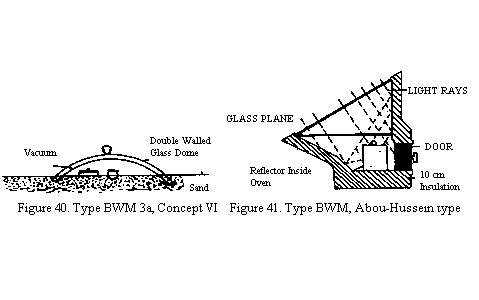

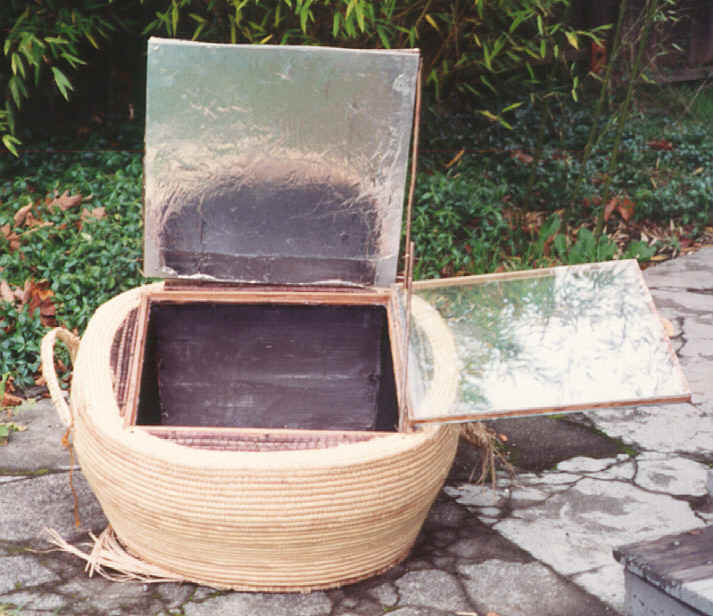
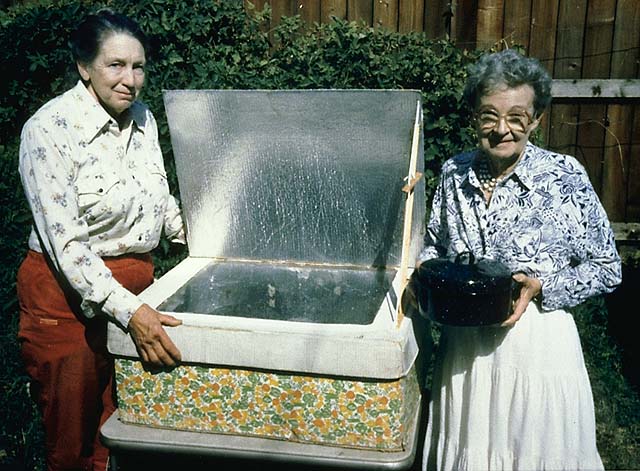
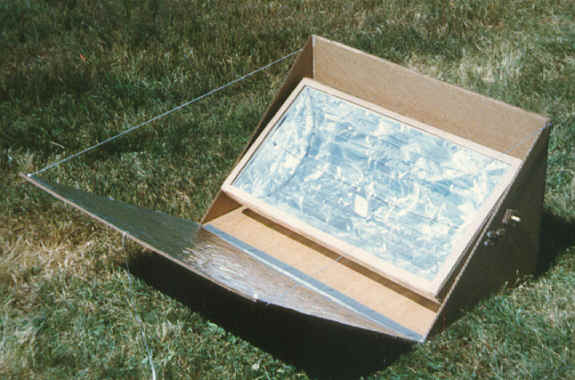

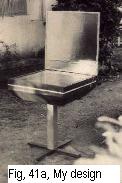
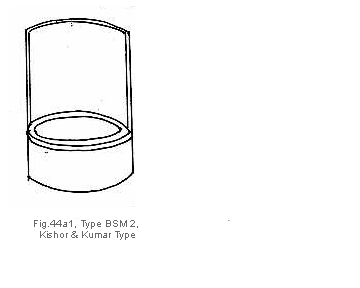
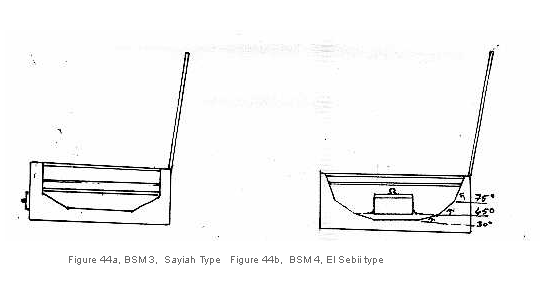
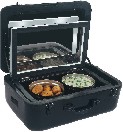
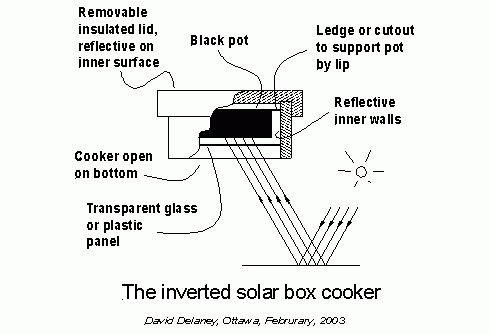
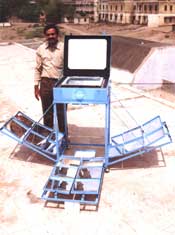
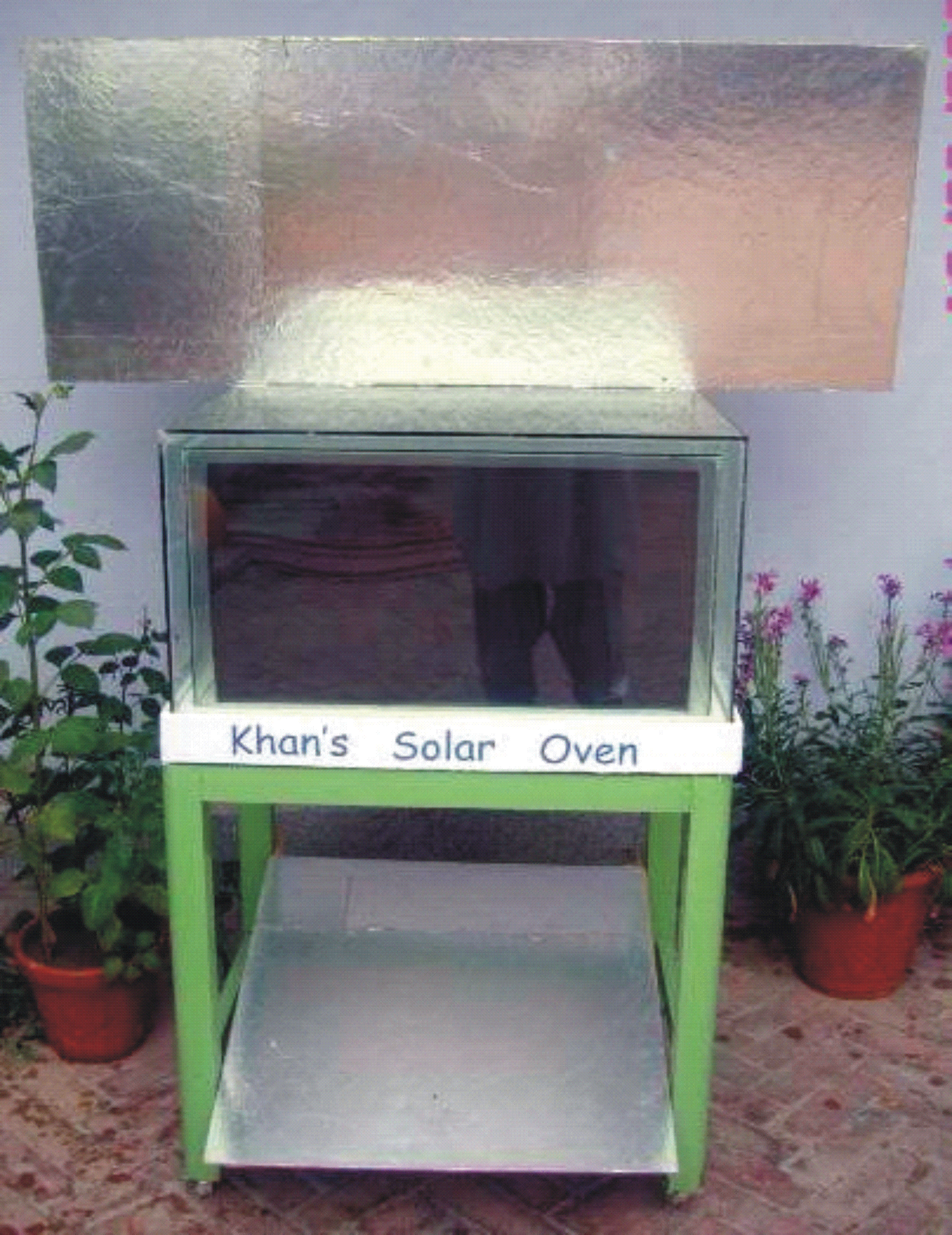
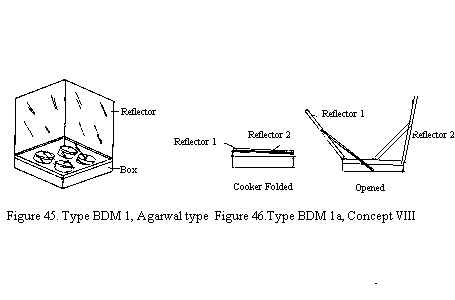
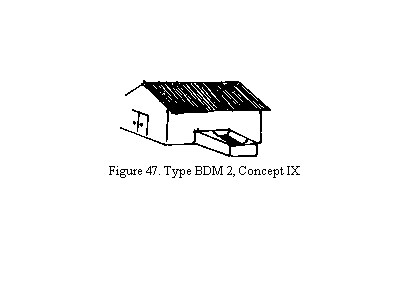
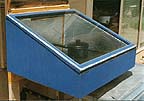
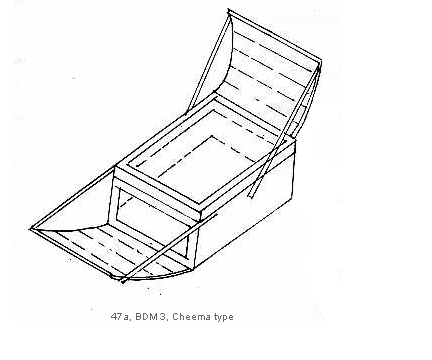

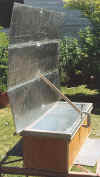
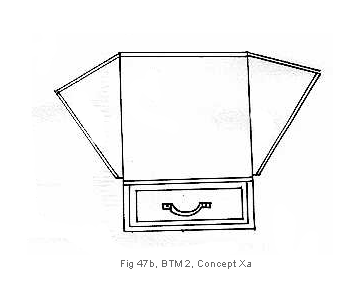
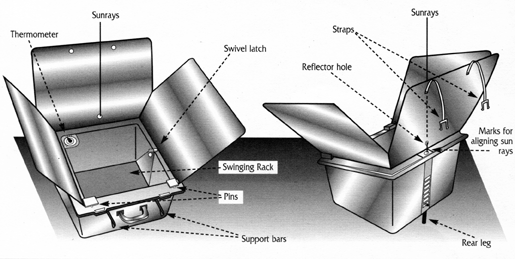
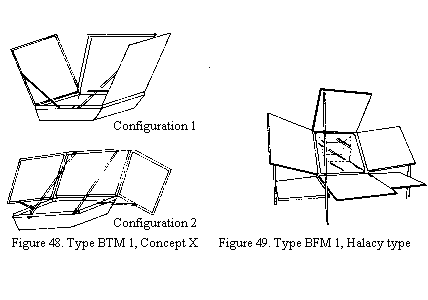

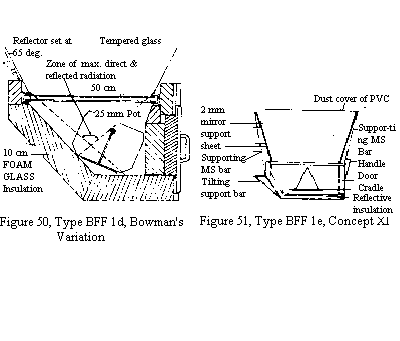
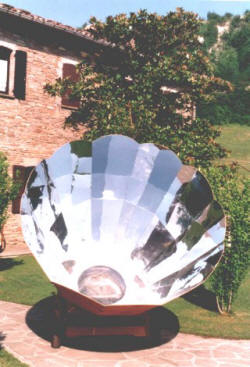
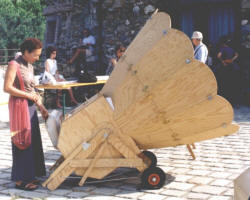
PREVIOUS PART
light from above
NEXT PART Box with 2 reflectors
Free Hit Counter